
The Katipunan, officially the Kataastaasan Kagalang-galang na Katipunan ng mga Anak ng Bayan and abbreviated as the KKK, was a revolutionary organization founded in 1892 by a group of Filipino nationalists Deodato Arellano, Andrés Bonifacio, Valentin Diaz, Ladislao Diwa, José Dizon, and Teodoro Plata. Its primary objective was achieving independence from the Spanish Empire through an armed revolution. It was formed as a secret society before its eventual discovery by Spanish authorities in August 1896. This discovery led to the start of the Philippine Revolution.
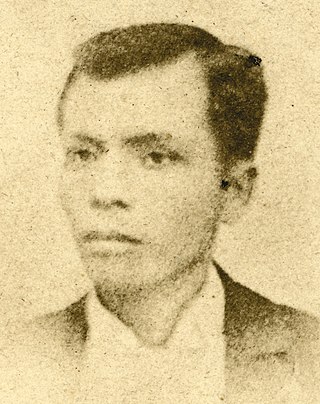
Andrés Bonifacio y de Castro was a Filipino revolutionary leader. He is often called "The Father of the Philippine Revolution", and considered a national hero of the Philippines.
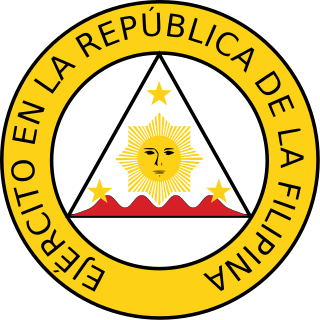
The Philippine Revolutionary Army, later renamed Philippine Republican Army, was the official armed forces of the First Philippine Republic from its formation in March 1897 to its dissolution in November of 1899 in favor of guerrilla operations in the Philippine–American War.

The national flag of the Philippines is a horizontal bicolor flag with equal bands of royal blue and crimson red, with a white, equilateral triangle at the hoist. In the center of the triangle is a golden-yellow sun with eight primary rays, to represent the original eight provinces that rebelled against the Spanish during the 1896 Philippine Revolution. At each vertex of the triangle is a five-pointed, golden-yellow star, each of which representing one of the country's three main island groups—Luzon, Visayas, and Mindanao. The white triangle at the hoist represents liberty, equality, and fraternity. A unique feature of this flag is its usage to indicate a state of war if it is displayed with the red side on top, which is effectively achieved by flipping the flag upside-down.
During the Philippine Revolution, various flags were used by the Katipunan secret society and its various factions, and later, after the Katipunan's dissolution, the Philippine Army and its civil government.

The Philippine Revolution was a war of independence waged by the revolutionary organization Katipunan against the Spanish Empire from 1896 to 1898. It was the culmination of the 333-year colonial rule of Spain to the archipelago. The Philippines were among the last colonies of the Spanish Empire, which saw a massive decline particularly in the 1890s. Cuba rebelled in 1895, and the empire soon fought against the United States in a war that they lost. In June 1898, Philippine revolutionaries declared independence. However, this was not recognized by Spain, which sold the islands to the United States in the Treaty of Paris.

Mariano Malia Álvarez was a Filipino revolutionary and statesman.
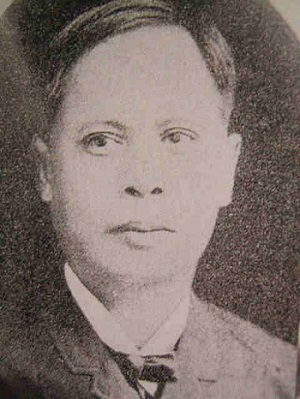
Deodato Arellano y de la Cruz was a Filipino propagandist and the first president of the Katipunan, which was founded at his home in Azcarraga Street, Manila. He was first to be given the title Supremo by the Katipunan. After studying bookkeeping in Ateneo de Municipal de Manila, he became an assistant clerk for the Spanish military. He was a member of the Freemasonry in the Philippines and became involved in the Propaganda Movement.

The Tejeros Convention, also known as the Tejeros Assembly and the Tejeros Congress, was a meeting held on March 22, 1897, between Katipunan factions of Magdiwang and Magdalo in San Francisco de Malabon, Cavite that resulted in the creation of a new revolutionary government that took charge of the Philippine Revolution, replacing the Katipunan. It followed on a previous meeting now known as the Imus Assembly. Filipino historians consider the first presidential and vice presidential elections in Philippine history to have been held at this convention, although only Katipuneros were able to take part, and not the general populace.

Pío del Pilar was a Filipino revolutionary general. He was one of the lead figures in the Philippine Revolution, and fought major battles in Manila and Cavite.

The Magdiwang was a faction of the Katipunan, a Philippine revolutionary organization founded by Filipino rebels in Manila in 1892 with the aim to gain independence from Spain. The Magdiwang Council was acknowledged as "the supreme organ responsible for the successful campaigns against the enemy" within Cavite.

The Magdalo was a faction of the Katipunan chapter in Cavite.
Daniel Tirona y Tria was a Filipino politician. He became infamous for causing divisions within the Philippine revolutionary movement and for insulting and maligning Andres Bonifacio during the Tejeros Convention in 1897.
The Imus Assembly was the meeting held between the Magdalo and Magdiwang factions of the Katipunan at Imus, Cavite, Philippines, on December 31, 1896, the day following the execution of José Rizal. This was convened in order to settle the leadership dispute between the two factions.

The Battle of Binakayan–Dalahican was a simultaneous battle during the Philippine Revolution that was fought on November 9–11, 1896 that led to a decisive Filipino victory. The twin battle took place at the shores of Binakayan, in the town of Cavite Viejo ; Dalahican and Dagatan in Noveleta; and, to minimal extent, in Imus and Bacoor towns in Cavite, Philippines that lasted for two days before the Spanish army retreated demoralized and in disarray. The result of the battle was the first significant Filipino victory in the country's history.
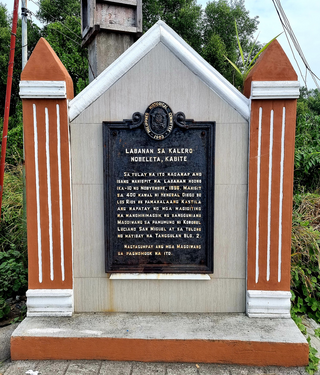
The Battle of Noveleta known as Battle of Calero Bridge was a major battle during the Philippine revolution and was one of the first engagements of the revolution in Cavite. In the latter part of the revolution, Noveleta played a key role for the Magdalo and Magdiwang factions. From its capture by the Magdiwang at the start of the revolution, various battles were fought and won by Filipino rebels in Cavite. Noveleta became the seat of the Magdiwang faction of the Katipunan.
The Marangál na Dalit ng̃ Katagalugan is a song of the Philippine Revolution composed in November 1896 by Julio Nakpil at the request of Andres Bonifacio as the anthem of the revolutionary Tagalog Republic. However, this nascent revolutionary government was displaced and superseded by a succession of revolutionary governments headed by Emilio Aguinaldo and the composition known today as Lupang Hinirang became the national anthem of the Republic of the Philippines.
This is the timeline of the Philippine Revolution—the uprising that gave birth to Asia's first republic. The roots of the revolution trace back to the Cavite mutiny and subsequent execution of Gomburza in 1872, and ended with the declaration of independence from Spain in 1898.
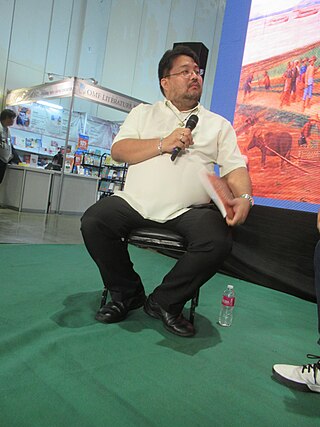
Michael Charleston "Xiao" Briones Chua is a Filipino historian, academic, and television personality.
A revolutionary government or provisional government has been declared a number of times in the Philippines, by various insurgent groups.































